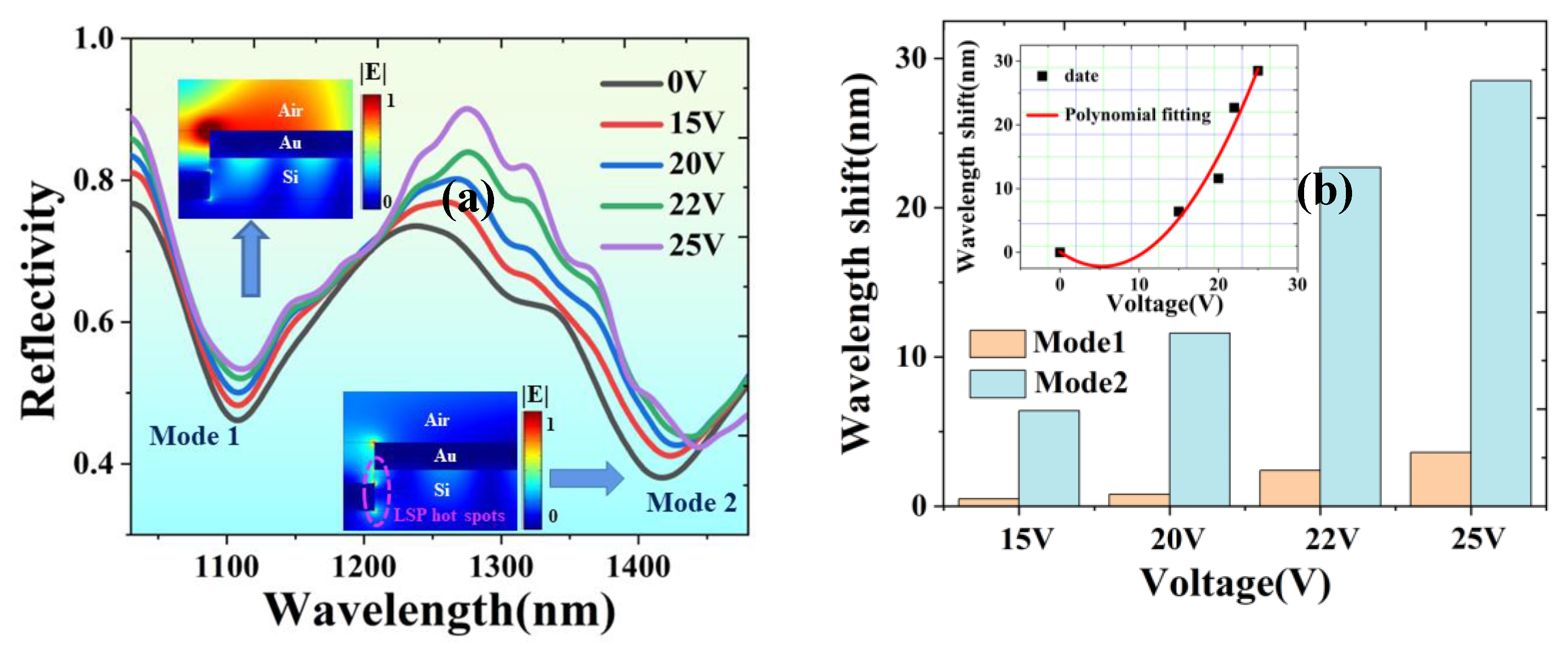Fano-Like Resonance of Heat-Reconfigurable Silicon Grating Metasurface Tuned by Laser-Induced Graphene
Abstract
:1. Introduction
2. Structure and Method
3. Discussion
3.1. Analysis of Fano Resonance Formation
3.2. Analysis of the Influence of Composite Au Grating Parameters on Fano Resonance
3.3. Dynamic Tuning of Fano Resonance by Laser-Induced Graphene(LIG)
4. Conclusions
Author Contributions
Funding
Institutional Review Board Statement
Informed Consent Statement
Data Availability Statement
Conflicts of Interest
References
- Fano, U. Effects of configuration interaction on intensities and phase shifts. Phys. Rev. 1961, 124, 1866. [Google Scholar] [CrossRef]
- Miroshnichenko, A.E.; Flach, S.; Kivshar, Y.S. Fano resonances in nanoscale structures. Rev. Mod. Phys. 2010, 82, 2257. [Google Scholar] [CrossRef] [Green Version]
- Chen, J.; Gan, F.; Wang, Y.; Li, G. Plasmonic devices: Plasmonic sensing and modulation based on Fano resonances (Advanced Optical Materials 9/2018). Adv. Opt. Mater. 2018, 6, 1870034. [Google Scholar] [CrossRef] [Green Version]
- He, Z.; Xue, W.; Cui, W.; Li, C.; Li, Z.; Pu, L.; Li, G. Tunable Fano resonance and enhanced sensing in a simple Au/TiO2 hybrid metasurface. Nanomaterials 2020, 10, 687. [Google Scholar] [CrossRef] [Green Version]
- Mun, S.E.; Yun, H.; Choi, C.; Kim, S.J.; Lee, B. Enhancement and switching of Fano resonance in metamaterial. Adv. Opt. Mater. 2018, 6, 1800545. [Google Scholar] [CrossRef]
- Sun, Y.; Zhang, L.; Shi, H.; Cao, S.; Yang, S.; Wu, Y. Near-infrared plasma cavity metasurface with independently tunable double Fano resonances. Results Phys. 2021, 25, 104204. [Google Scholar] [CrossRef]
- Fang, Z.; Cai, J.; Yan, Z.; Nordlander, P.; Halas, N.J.; Zhu, X. Removing a wedge from a metallic nanodisk reveals a Fano resonance. Nano Lett. 2011, 11, 4475–4479. [Google Scholar] [CrossRef]
- Verellen, N.; Sonnefraud, Y.; Sobhani, H.; Hao, F.; Moshchalkov, V.V.; Dorpe, P.V.; Maier, S.A. Fano resonances in individual coherent plasmonic nanocavities. Nano Lett. 2009, 9, 1663–1667. [Google Scholar] [CrossRef]
- Li, G.; Hu, H.; Wu, L. Tailoring Fano lineshapes using plasmonic nanobars for highly sensitive sensing and directional emission. Phys. Chem. Chem. Phys. 2019, 21, 252–259. [Google Scholar] [CrossRef]
- Lodewijks, K.; Ryken, J.; Van Roy, W.; Borghs, G.; Lagae, L.; Van Dorpe, P. Tuning the Fano resonance between localized and propagating surface plasmon resonances for refractive index sensing applications. Plasmonics 2013, 8, 1379–1385. [Google Scholar] [CrossRef] [Green Version]
- Nicolas, R.; Lévêque, G.; Marae-Djouda, J.; Montay, G.; Madi, Y.; Plain, J.; Maurer, T. Plasmonic mode interferences and Fano resonances in Metal-Insulator-Metal nanostructured interface. Sci. Rep. 2015, 5, 1–11. [Google Scholar] [CrossRef] [PubMed] [Green Version]
- Jia, S.; Li, Z.; Chen, J. High-sensitivity plasmonic sensor by narrowing Fano resonances in a tilted metallic nano-groove array. Opt. Express 2021, 29, 21358–21368. [Google Scholar] [CrossRef] [PubMed]
- Fang, X.; Xiong, L.; Shi, J.; Ding, H.; Li, G. Narrow quadrupolar surface lattice resonances and band reversal in vertical metal-insulator-metal gratings. J. Phys. D Appl. Phys. 2021, 55, 025111. [Google Scholar] [CrossRef]
- Hua, Y.; Fumani, A.K.; Odom, T.W. Tunable lattice plasmon resonances in 1D nanogratings. ACS Photonics 2019, 6, 322–326. [Google Scholar] [CrossRef]
- Fang, X.; Xiong, L.; Shi, J.; Li, G. High-Q quadrupolar plasmonic lattice resonances in horizontal metal–insulator–metal gratings. Opt. Lett. 2021, 46, 1546–1549. [Google Scholar] [CrossRef] [PubMed]
- Christ, A.; Ekinci, Y.; Solak, H.H.; Gippius, N.A.; Tikhodeev, S.G.; Martin, O.J.F. Controlling the Fano interference in a plasmonic lattice. Phys. Rev. B 2007, 76, 201405. [Google Scholar] [CrossRef] [Green Version]
- Zeng, B.; Gao, Y.; Bartoli, F.J. Rapid and highly sensitive detection using Fano resonances in ultrathin plasmonic nanogratings. Appl. Phys. Lett. 2014, 105, 161106. [Google Scholar] [CrossRef]
- Wang, Y.; Sun, C.; Li, H.; Gong, Q.; Chen, J. Self-reference plasmonic sensors based on double Fano resonances. Nanoscale 2017, 9, 11085–11092. [Google Scholar] [CrossRef]
- Lee, K.L.; Chen, P.W.; Wu, S.H.; Huang, J.; Yang, S.; Wei, P. Enhancing surface plasmon detection using template-stripped gold nanoslit arrays on plastic films. ACS Nano 2012, 6, 2931–2939. [Google Scholar] [CrossRef]
- Novotny, L.; Hecht, B. Surface plasmons. Princ. Nano Opt. 2006, 90, 378. [Google Scholar]
- Emani, N.K.; Chung, T.F.; Kildishev, A.V.; Shalaev, V.M.; Chen, Y.P.; Boltasseva, A. Electrical modulation of fano resonance in plasmonic nanostructures using graphene. Nano Lett. 2014, 14, 78–82. [Google Scholar] [CrossRef] [PubMed]
- Werner, W.S.; Glantschnig, K.; Ambrosch-Draxl, C. Optical constants and inelastic electron-scattering data for 17 elemental metals. J. Phys. Chem. Ref. Data 2009, 38, 1013–1092. [Google Scholar] [CrossRef]
- Zhu, J.; Wang, X.; Qi, Y.; Yu, J. Plasmonic sensor with self-reference capability based on functional layer film composed of Au/Si gratings. Chin. Phys. B 2022, 31, 014206. [Google Scholar] [CrossRef]
- Lin, J.; Peng, Z.; Liu, Y.; Ruiz-Zepeda, F.; Ye, R.; Samuel, E.L.; Tour, J.M. Laser-induced porous graphene films from commercial polymers. Nat. Commun. 2014, 5, 1–8. [Google Scholar] [CrossRef] [PubMed] [Green Version]









Disclaimer/Publisher’s Note: The statements, opinions and data contained in all publications are solely those of the individual author(s) and contributor(s) and not of MDPI and/or the editor(s). MDPI and/or the editor(s) disclaim responsibility for any injury to people or property resulting from any ideas, methods, instructions or products referred to in the content. |
© 2023 by the authors. Licensee MDPI, Basel, Switzerland. This article is an open access article distributed under the terms and conditions of the Creative Commons Attribution (CC BY) license (https://creativecommons.org/licenses/by/4.0/).
Share and Cite
Ma, Y.; Huang, Y.; Zhu, Y.; Zhou, H.; Yan, C.; Wang, S.; Deng, G.; Zhou, S. Fano-Like Resonance of Heat-Reconfigurable Silicon Grating Metasurface Tuned by Laser-Induced Graphene. Nanomaterials 2023, 13, 492. https://doi.org/10.3390/nano13030492
Ma Y, Huang Y, Zhu Y, Zhou H, Yan C, Wang S, Deng G, Zhou S. Fano-Like Resonance of Heat-Reconfigurable Silicon Grating Metasurface Tuned by Laser-Induced Graphene. Nanomaterials. 2023; 13(3):492. https://doi.org/10.3390/nano13030492
Chicago/Turabian StyleMa, Yukuan, Yulei Huang, Yuehong Zhu, Hao Zhou, Congliao Yan, Shutong Wang, Guoliang Deng, and Shouhuan Zhou. 2023. "Fano-Like Resonance of Heat-Reconfigurable Silicon Grating Metasurface Tuned by Laser-Induced Graphene" Nanomaterials 13, no. 3: 492. https://doi.org/10.3390/nano13030492




